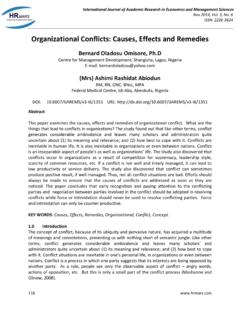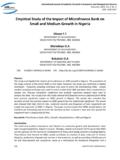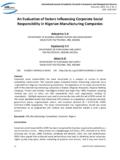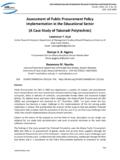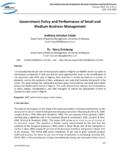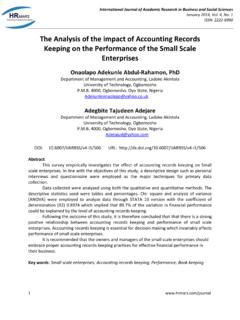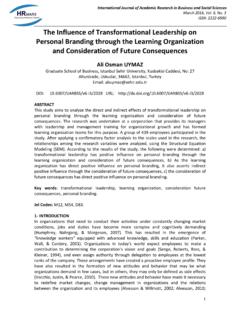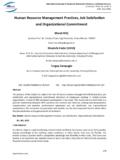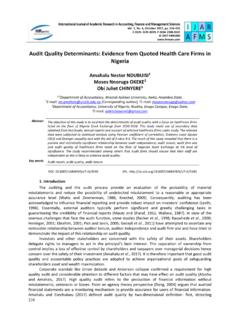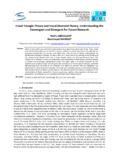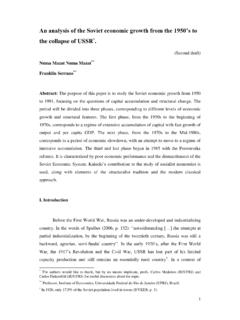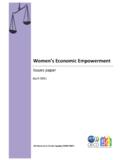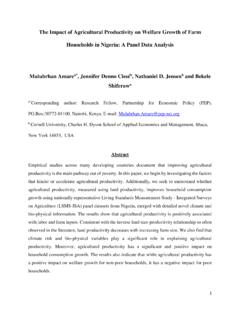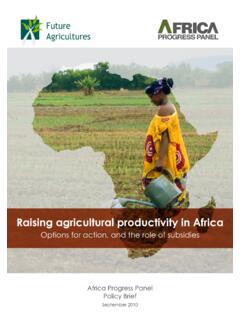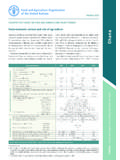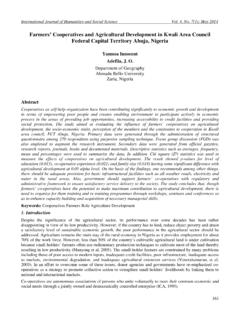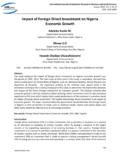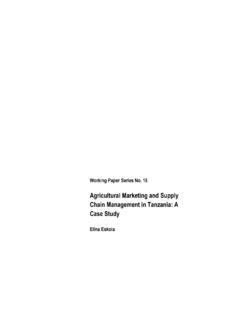Transcription of Agricultural Credit and Economic Growth Nexus. Evidence ...
1 International Journal of Academic Research in Accounting, Finance and Management Sciences Vol. 6, , April 2016, pp. 146 158. E-ISSN: 2225-8329, P-ISSN: 2308-0337. 2016 HRMARS. Agricultural Credit and Economic Growth Nexus. Evidence from Nigeria I. Omosebi AYEOMONI1. Saheed A. ALADEJANA2. 1. Adekunle Ajasin University, Akungba-Akoko, Ondo State, Nigeria, 1E-mail: 2. Department of Economics, Adekunle Ajasin University, Akungba-Akoko, Ondo State, Nigeria, 2. E-mail: Abstract The significant role of Agricultural sector cannot be underestimated in any nation. It has been the source of feeding of the populace and income generation for other developmental activities. As a result, various governments have been making concerted efforts to improve Economic Growth and Agricultural productivity through Agricultural Credit but rarely one can see any improvement in the sector.
2 It is in line with these its fundamental role that this study makes a giant stride to examine the relationship between Agricultural Credit and Economic Growth in Nigeria. The study employed time series data from Central Bank of Nigeria, Statistical Bulletin and National Bureau of Statistics which spanned from 1986-2014. This study carried out Auto-Regressive Distributed Lag (ARDL) approach to investigate the variables. The findings showed that short and long run relationship existed between Agricultural Credit and Economic Growth in both short and long run respectively. Moreover, real exchange rate and private domestic investment as control variables had direct effect on Economic Growth whereas inflation rate revealed an inverse relationship in the model.
3 The study concluded that Economic Growth is influenced by dynamic variables such as Credit to Agricultural sector, real exchange rate, real interest rate, private domestic investment and inflation rate in Nigeria. The study therefore suggested that concerted efforts should be made by policy makers to increase the level of productivity of Agricultural sector in Nigeria through adequate Credit to the sector so as to boost the Growth of the economy. Key words Agricultural Credit , Agricultural sector, autoregressive distributed lag, Economic Growth DOI: URL: 1. Introduction Agriculture holds the potential in accelerating the pace of Economic Growth and development of several countries of the world.
4 It is the largest single employer and contributor to GDP in most of African countries (IFAD, 2001). In Nigeria, during the pre and immediate post Independence era, the economy was predicated on agriculture. Agriculture contributed 90% of the Nation's GDP and foreign exchange before oil boom was discovered in Nigeria in early 1970s in commercial quantity and also provides subsistence for two third (2/3) of Nigerians who are low income earners in the economy. Agriculture Credit is essentially a development strategy in a variety of ways. It promotes Agricultural investment and adoption of technology necessary to spur Economic Growth . Although, agriculture finance is only one of the Growth factors, it is one of the more important factors in attaining the objectives for development.
5 Mallik (2008) identified three gaps as problems to Growth of agriculture in most African economies. The gaps are (i) savings gap, (ii) trade balance gap and (iii) fiscal gap. In general, most African countries (Nigeria inclusive) have inadequate levels of domestic savings, which could be directed to investment. Apart from employing about of labour force in Nigeria and accounting for 70% of GDP of the non oil sector (Bureau of Statistics, 2010). It also contributed more than of export earnings (Linda, 2001). Nigeria is still endowed with huge expanse of fertile Agricultural lands, as well as, other resources that can be harnessed to transform the economy. In spite of these potentials reported that the sector is still construed by low productivity.
6 For instance, its contribution to GDP averaged 12% in the 1970s, which International Journal of Academic Research in Accounting, Finance and Management Sciences Vol. 6 (2), pp. 146 158, 2016 HRMARS. resulted in rising import bills leading to huge deficit in the balance of payment. Accordingly, fulfilling its traditional role of food provision, employment and foreign exchange generation has been constrained by various socio- Economic and financial related problems among which are: poor funding, inadequate Credit to local farmers and agro-firm's owners, as well as, unstable macroeconomic policies. In support, Alabi and Chime (2008) have attributed the present Economic problem in Nigeria to the poor performance of the Agricultural sector.
7 Apart from oil discovery and the oil boom of the early 1970s which resulted in the negligence of the Agricultural sector, Iwayemi (1994) and Ijaiya (2000) likened the dismal performance of Agricultural sector to the effect of global Economic crisis of the 1980s and the continuous decline in government finance to the sector. In Africa, government spending on agriculture and health was particularly strong in promoting Economic Growth . Asia's investments in agriculture, education, and defence had positive Growth -promoting effects. However, all types of government spending except health were statistically insignificant. They also showed that Growth in Agricultural production is most crucial for poverty alleviation in rural areas.
8 Agricultural spending, irrigation, education and roads all contributed strongly to this Growth . Disaggregating total Agricultural expenditures into research and non-research spending revealed that research had a much larger impact on productivity than non-research spending. There are also some studies which attempted to link government spending to Agricultural Growth and poverty reduction. In recognition of the role of Agricultural sector, successive government have formulated and implemented several financial programmes all aimed at ensuring availability of funds to Agricultural sector in order to boost real sectors thereby lead to Economic Growth and development. Among the arrays of such financial Schemes include: the establishment of the Nigerian Agricultural Cooperative bank (NACB) in 1973, establishment of the Agricultural Credit Guarantee Scheme Fund (ACGSF) in 1977, introduction of the mandatory sectoral allocation to agriculture in 1972, launching of the rural banking Scheme in 1977, setting up of the Commercial Agriculture Credit Scheme in 2009, launching of the Agricultural Credit Support Scheme (ACSS), as well as, the merging of NACB, People's bank and the Family Economic Advancement Programme (FEAP) to form the Nigerian Agricultural Cooperative and Rural Development Bank (NACRDB) in 2000.
9 A number of government policies and programmes have been designed to facilitate the flow of these Credit to farmers' in order to mechanize and improve Agricultural activities which ultimately should enhance food sufficiency, increase farmers' income, provide essential raw- materials for the local agro- based industries and to reduce importation of Agricultural products in the economy. To achieve these, CBN. has given directives to commercial banks which are part of the financial Institutions saddled with the responsibility of mobilizing Credit to Agricultural sector. Despite the existence of several financial institutions, Credit requirements of farmers are often not met. In most cases where funds are given by banks, delay in disbursement of loans approved by government constitutes an impediment (Aku, 1995).
10 Most times, these loans get to the farmer after the planting season thereby resulting to diversion and subsequent default. With the high rate of loan default that characterized developing countries, Commercial banks seldom approve loans to farmers and often times do so at higher interest rates with other stringent conditions such as the provision of collateral (Bassey et al., 2014a). In support, Shekhar and Shekhar (2005). reported that commercial banks are discouraged from devoting their attention to Agricultural sector because of the Economic nature of land holdings, the poor resources of agriculturists and lack of securities acceptable by banks. The extent and the magnitude of this Credit have actually affected the farmers and undermined over the years.
